Abstract
In a medium containing ammonia, proteose peptone, and cysteine as nitrogen sources, 17 of 24 Bacteroidaceae strains, 3 of Selenomonas strains, 1 of 7 curved rods, 3 of 7 Spirochaetaceae strains, 8 of 20 Eubacterium strains, 8 of 13 Peptococcaceae strains, 3 of 4 Clostridium strains, 19 of 20 Enterobacteriaceae strains, and 1 of 8 Streptococcus strains utilized ammonia nitrogen preferentially to proteose peptone nitrogen. To determine the ability of intestinal microbes to synthesize amino acids from ammonia, ammonia utilization by Bacteroides ruminicola strain 9 was studied in defined media containing ammonia and other nitrogen sources. In another medium containing ammonia, proteose peptone, and cysteine as nitrogen sources, ammonia was preferentially utilized even when the proteose peptone nitrogen content was eight times greater than that of ammonia nitrogen. In a medium containing ammonia, an amino acid, and cysteine, the lowest uptake of ammonia nitrogen was observed when the medium contained aspartic acid, glutamic acid, threonine, or alanine; but ammonia was utilized more effectively than any of the amino acids. Incorporation of 15N from [15N]ammonia into bacterial amino acids was studied. 15N was incorporated into every amino acid of B. ruminicola strain 9, and the highest uptake was observed in aspartic acid and alanine.
Full text
PDF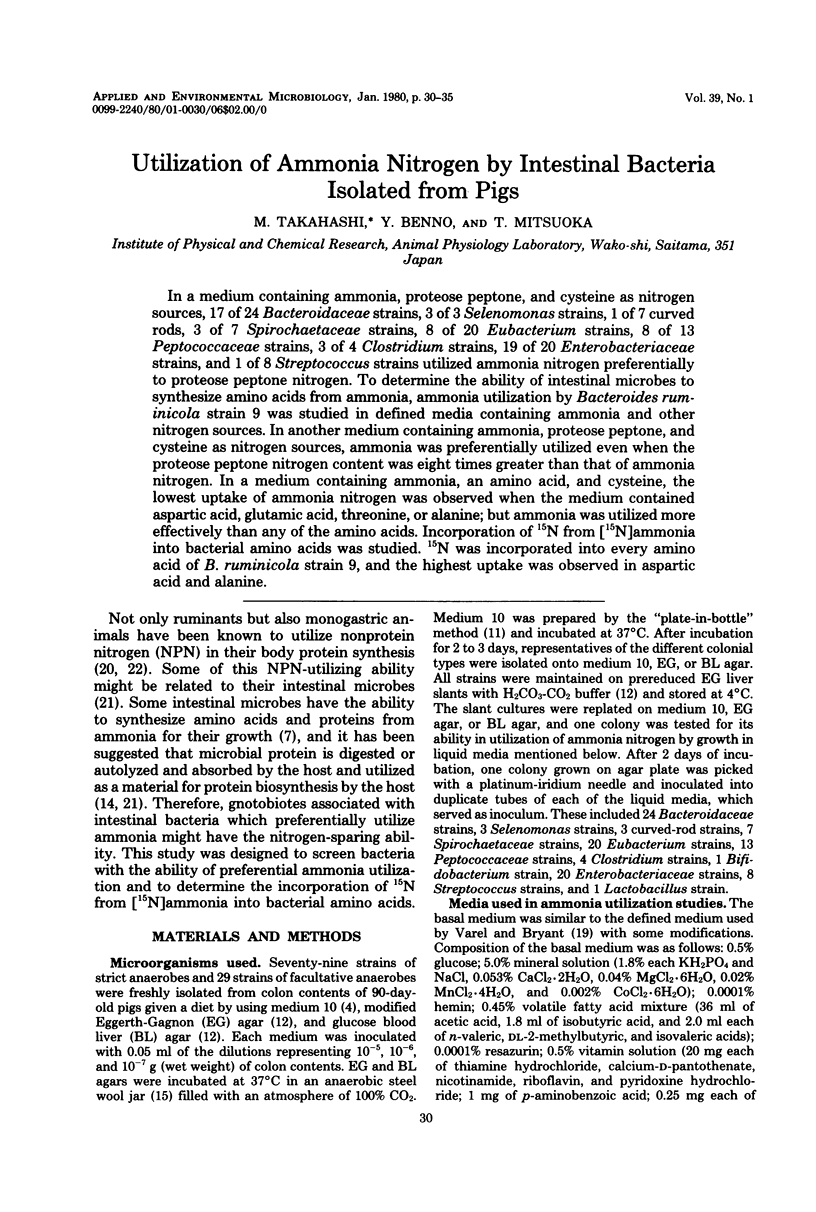
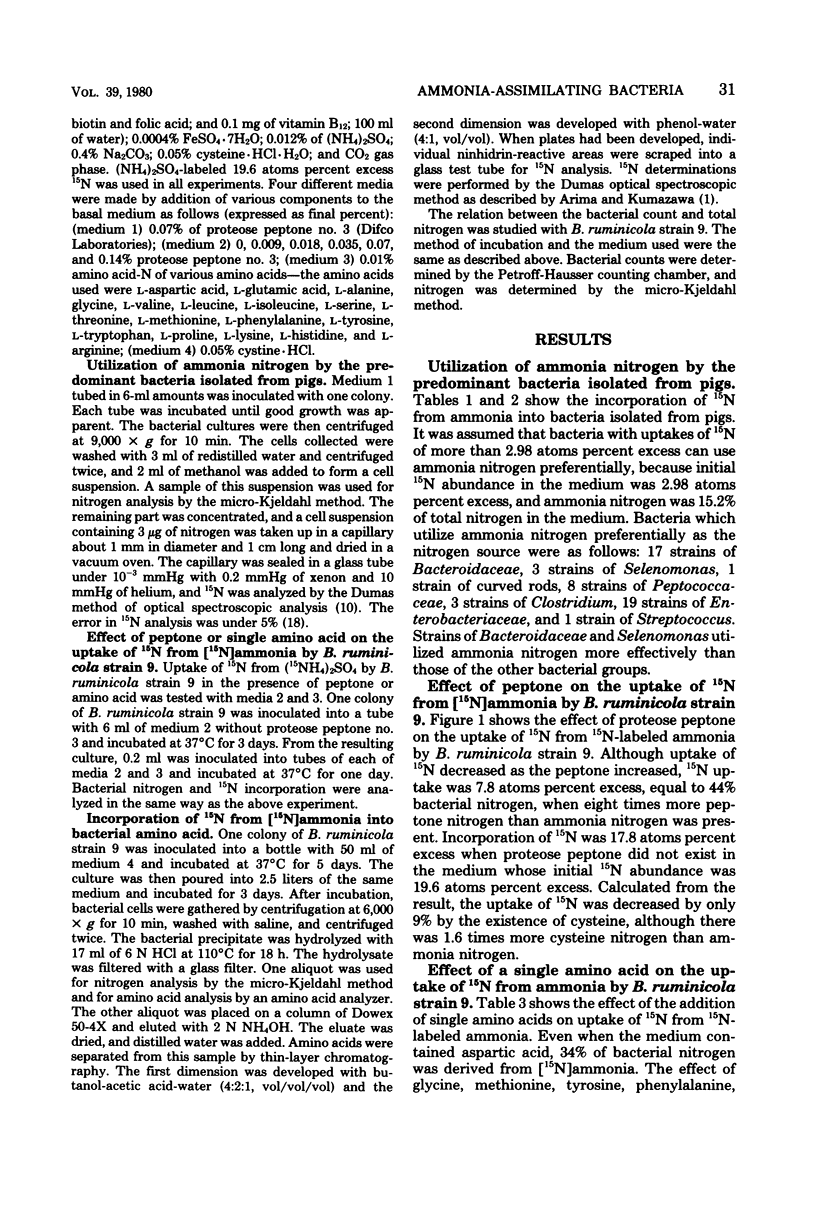
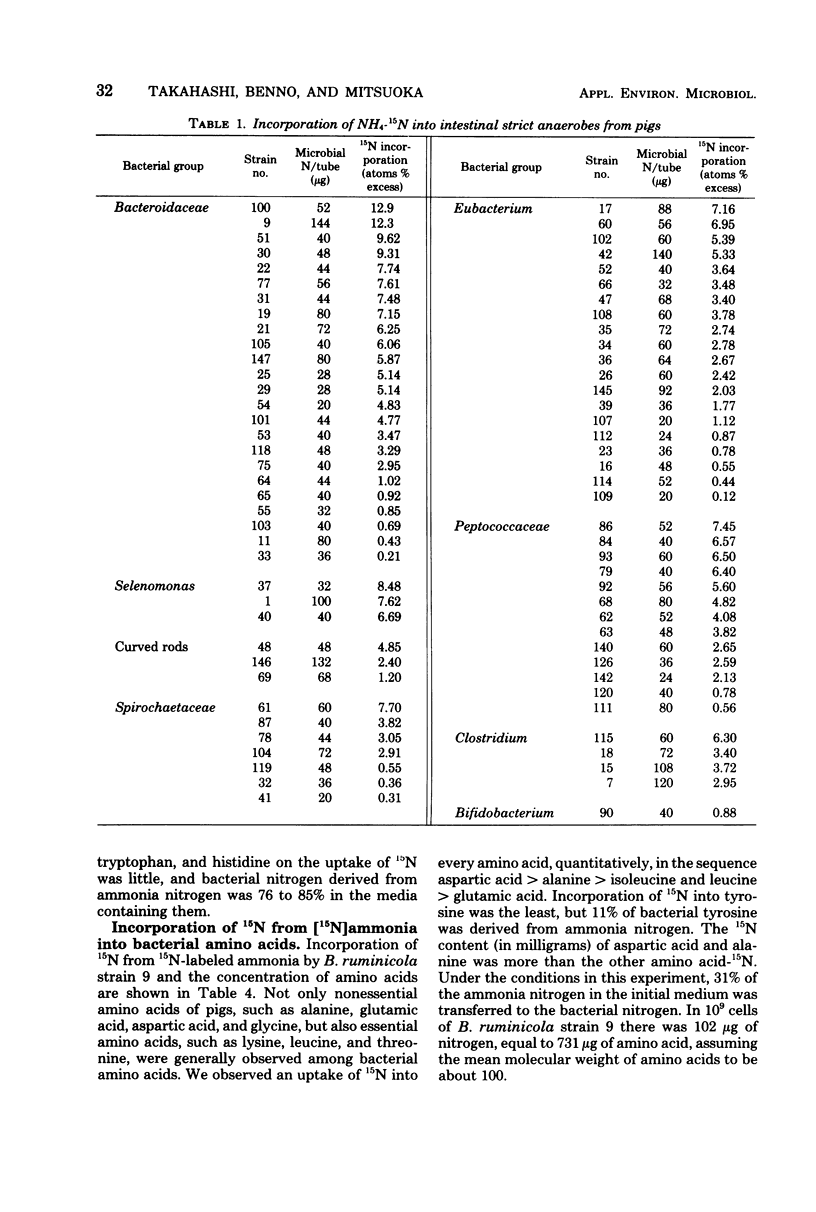

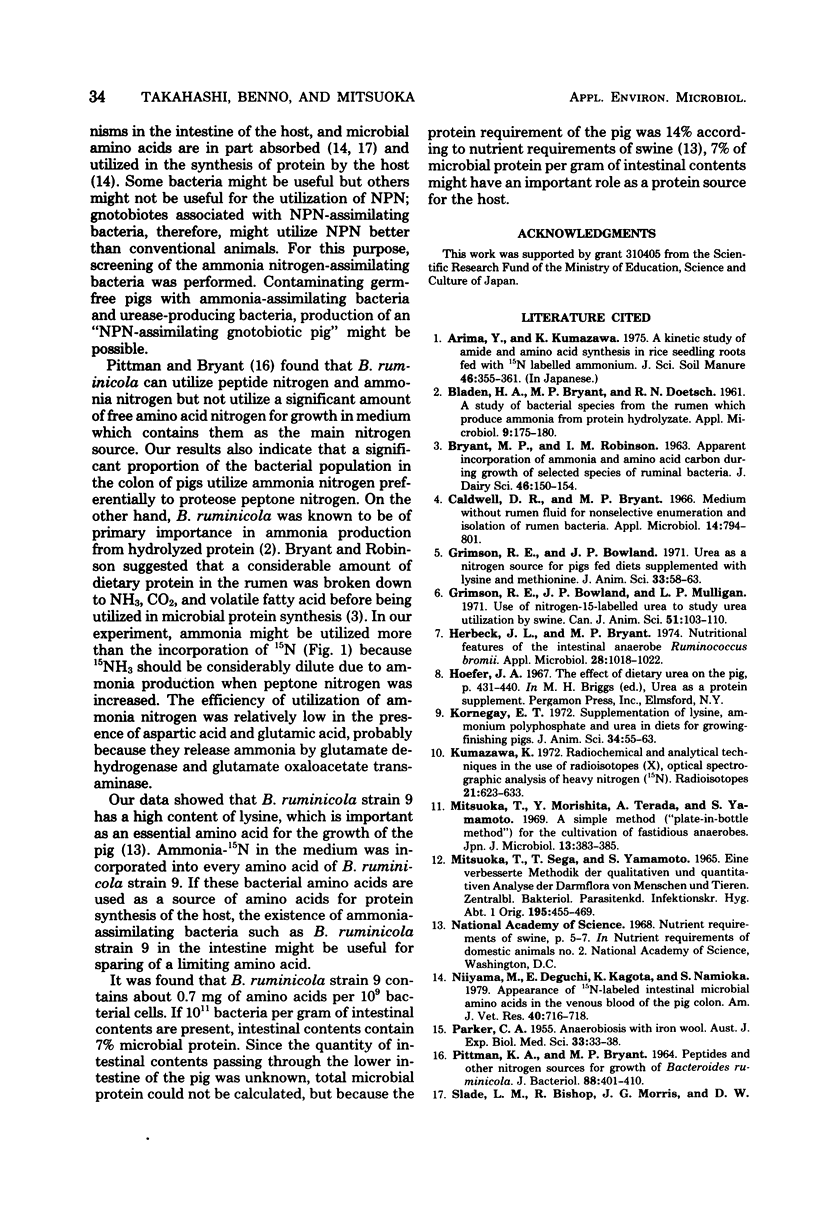
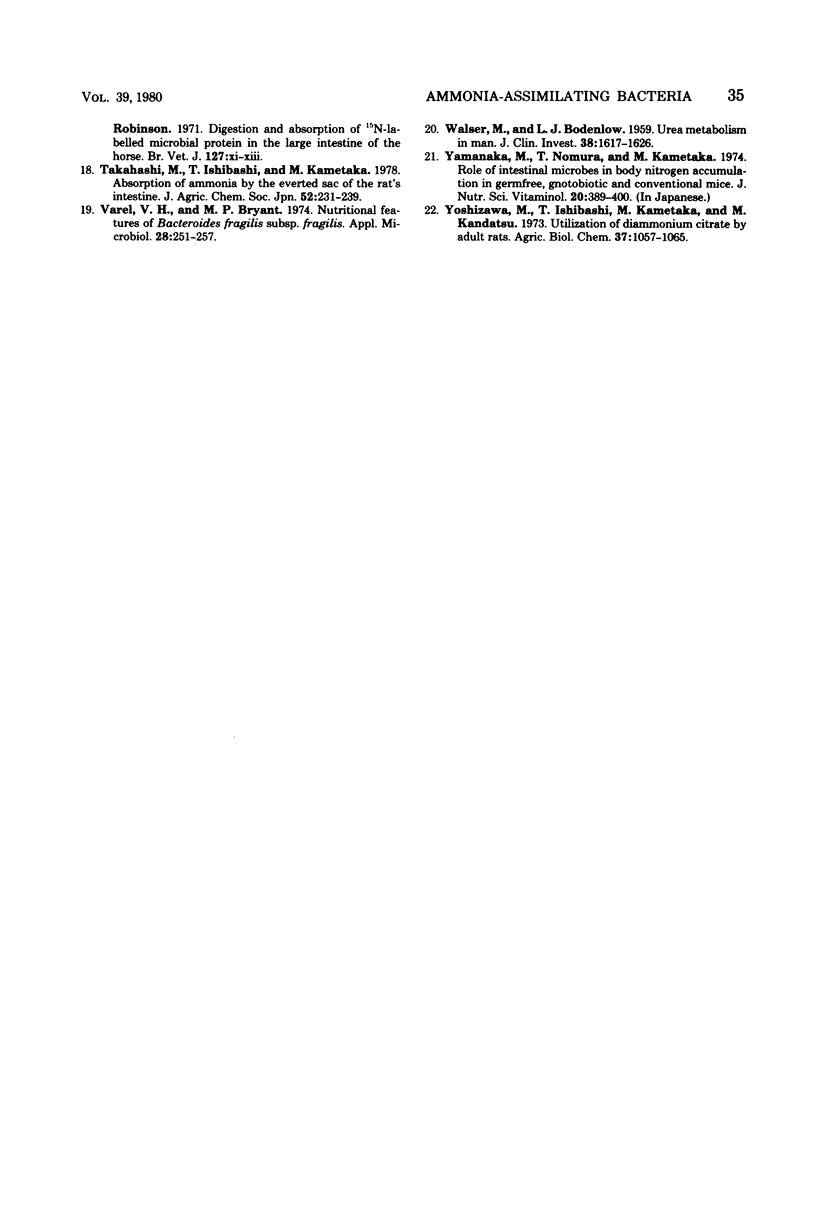
Selected References
These references are in PubMed. This may not be the complete list of references from this article.
- Bladen H. A., Bryant M. P., Doetsch R. N. A Study of Bacterial Species from the Rumen Which Produce Ammonia from Protein Hydrolyzate. Appl Microbiol. 1961 Mar;9(2):175–180. doi: 10.1128/am.9.2.175-180.1961. [DOI] [PMC free article] [PubMed] [Google Scholar]
- Caldwell D. R., Bryant M. P. Medium without rumen fluid for nonselective enumeration and isolation of rumen bacteria. Appl Microbiol. 1966 Sep;14(5):794–801. doi: 10.1128/am.14.5.794-801.1966. [DOI] [PMC free article] [PubMed] [Google Scholar]
- Grimson R. E., Bowland J. P. Urea as a nitrogen source for pigs fed diets supplemented with lysine and methionine. J Anim Sci. 1971 Jul;33(1):58–63. doi: 10.2527/jas1971.33158x. [DOI] [PubMed] [Google Scholar]
- Herbeck J. L., Bryant M. P. Nutritional features of the intestinal anaerobe Ruminococcus bromii. Appl Microbiol. 1974 Dec;28(6):1018–1022. doi: 10.1128/am.28.6.1018-1022.1974. [DOI] [PMC free article] [PubMed] [Google Scholar]
- Kornegay E. T. Supplementation of lysine, ammonium polyphosphate and urea in diets for growing-finishing pigs. J Anim Sci. 1972 Jan;34(1):55–63. doi: 10.2527/jas1972.34155x. [DOI] [PubMed] [Google Scholar]
- Mitsuoka T., Morishita Y., Terada A., Yamamoto S. A simple method ("plate-in-bottle method") for the cultivation of fastidious anaerobes. Jpn J Microbiol. 1969 Dec;13(4):383–385. doi: 10.1111/j.1348-0421.1969.tb00482.x. [DOI] [PubMed] [Google Scholar]
- Mitsuoka T., Sega T., Yamamoto S. Eine verbesserte Methodik der qualitativen und quantitativen Analyse der Darmflora von Menschen und Tieren. Zentralbl Bakteriol Orig. 1965 Mar;195(4):455–469. [PubMed] [Google Scholar]
- Niiyama M., Deguchi E., Kagota K., Namioka S. Appearance of 15N-labeled intestinal microbial amino acids in the venous blood of the pig colon. Am J Vet Res. 1979 May;40(5):716–718. [PubMed] [Google Scholar]
- PARKER C. A. Anaerobiosis with iron wool. Aust J Exp Biol Med Sci. 1955 Feb;33(1):33–37. doi: 10.1038/icb.1955.4. [DOI] [PubMed] [Google Scholar]
- PITTMAN K. A., BRYANT M. P. PEPTIDES AND OTHER NITROGEN SOURCES FOR GROWTH OF BACTEROIDES RUMINICOLA. J Bacteriol. 1964 Aug;88:401–410. doi: 10.1128/jb.88.2.401-410.1964. [DOI] [PMC free article] [PubMed] [Google Scholar]
- Varel V. H., Bryant M. P. Nutritional features of Bacteroides fragilis subsp. fragilis. Appl Microbiol. 1974 Aug;28(2):251–257. doi: 10.1128/am.28.2.251-257.1974. [DOI] [PMC free article] [PubMed] [Google Scholar]
- WALSER M., BODENLOS L. J. Urea metabolism in man. J Clin Invest. 1959 Sep;38:1617–1626. doi: 10.1172/JCI103940. [DOI] [PMC free article] [PubMed] [Google Scholar]
- Yamanaka M., Nomura T., Kametaka M. Role of intestinal microbes on body nitrogen accumulation in germfree, gnotobiotic and conventional mice. J Nutr Sci Vitaminol (Tokyo) 1974;20(5):389–400. doi: 10.3177/jnsv.20.389. [DOI] [PubMed] [Google Scholar]


